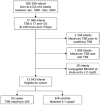Risk factors for severe hyperbilirubinemia among infants with borderline bilirubin levels: a nested case-control study
- PMID: 18534217
- PMCID: PMC3142930
- DOI: 10.1016/j.jpeds.2008.01.028
Risk factors for severe hyperbilirubinemia among infants with borderline bilirubin levels: a nested case-control study
Abstract
Objective: To estimate the effect of phototherapy and other predictors on the risk of total serum bilirubin (TSB) >or= 25 mg/dL in infants with a TSB of 17 to 22.9 mg/dL at age >or= 48 hours.
Study design: From a cohort of 285295 infants >or= 34 weeks gestation and >or= 2000 g born between 1995 and 2004 in northern California Kaiser hospitals, we identified 17986 with a TSB of 17 to 22.9 mg/dL at age >or= 48 hours. All infants exhibiting a TSB >or= 25 mg/dL were selected as cases for the study. Four randomly selected controls were matched to each case based on the difference between their qualifying TSB and the American Academy of Pediatrics' phototherapy threshold.
Results: A total of 62 cases were identified (0.4%). Six of these (10%) received inpatient phototherapy within 8 hours, along with 101 controls (41%) (adjusted odds ratio [AOR] 0.15; 95% confidence interval [CI] 0.06 to 0.40). Cases more often had lower gestational age (AOR 3.24; 95% CI 1.24 to 8.47 for 38 to 39 weeks and AOR = 3.70; 95% CI 0.61 to 22.4 for 34 to 37 weeks compared with >or= 40-week infants), bruising, (AOR 2.52; 95% CI 1.16 to 5.50), exclusive breast-feeding (AOR 2.09; 95% CI 1.05 to 4.03), and TSB increase of >or= 6 mg/dL/day (AOR 2.39; 95% CI 1.18 to 4.85).
Conclusions: Phototherapy was 85% effective in preventing TSB >or= 25 mg/dL. The strongest predictors of TSB >or= 25 mg/dL were gestational age, bruising, family history, and rapid rise in TSB.
Figures
References
-
- Subcommittee on Hyperbilirubinemia. Management of hyperbilirubinemia in the newborn infant 35 or more weeks of gestation. Pediatrics. 2004;114:297–316. - PubMed
-
- Atkinson LR, Escobar GJ, Takayama JI, Newman TB. Phototherapy use in jaundiced newborns in a large managed care organization: do clinicians adhere to the guideline? Pediatrics. 2003;111:e555–61. - PubMed
-
- Plastino R, Buchner DM, Wagner EH. Impact of eligibility criteria on phototherapy program size and cost. Pediatrics. 1990;85:796–800. - PubMed
-
- Kemper K, Forsyth B, McCarthy P. Jaundice, terminating breast-feeding, and the vulnerable child. Pediatrics. 1989;84:773–8. - PubMed
-
- American Academy of Pediatrics. Provisional Committee for Quality Improvement and Subcommittee on Hyperbilirubinemia. Practice parameter management of hyperbilirubinemia in the healthy term newborn. Pediatrics. 1994;94:558–65. - PubMed
Publication types
MeSH terms
Substances
Grants and funding
LinkOut - more resources
Full Text Sources
Other Literature Sources


